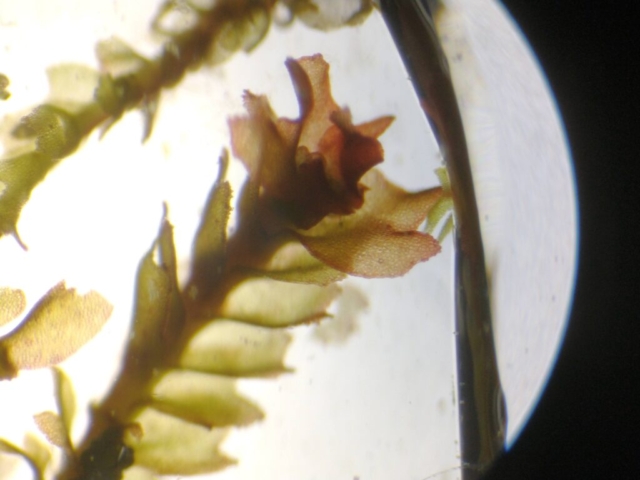The weather forecast for 10 December was for non-stop double rain all day, so it was a small and determined group that met at Swindale, three of us looking at bryophytes (Ian, Kerry and Clare) and Caz and Chris looking for lichens. We headed up the valley along the road, wading at times through deep puddles, to reach the bridge by the stepping stones over Swindale Beck. then followed the path to Gouthercrag Gill.
The first stop was by the bridge over the gill. There were many Racomitrium species on rocks near the water, including R. aciculare by the water’s edge, R. lanuginosum, R. heterostichum and R. fasciculare (both checked microscopically); also Polytrichum piliferum and a small cushion of Grimmia donniana with a single capsule. Some good mossy boulders had Barbilophozia attenuata and a small patch of Lophozia sudetica, tentatively identified by the red back to the stem and bilobed leaves. Later, under the dissecting microscope, some nice red perianths were found. A few yards from the beck, a rock face with water running down it had a good range of tufa moss: Amphidium mougeotii, Gymnostomum aeruginosum and Anoectangium aestivum, as well as Palustriella commutata, Conocephalum salebrosum, Preissia quadrata and Fissidens taxifolius. There were healthy patches of Loeskeobryum brevirostre by the beck, and a small amount of Fontinalis antipyretica at the edge of the water.
We headed away from the beck, past flushes where Dichodontium palustre was growing with Philonotis fontana and small amounts of Sphagnum auriculatum and S. inundatum. Scrambling up a slope that proved to be a stable boulder field, we found large amounts of Barbilophozia floerkei. In this promising habitat we hoped to find more Atlantic species such as Anastrepta orcadensis, but the Barbilophozia was predominant. Some of the boulders had large quantities of Gymnomitrion obtusum and some Andreaea rupestris, whilst low crags had cushions of Bartramia pommiformis. At the top of the boulder field, Gouther Crag provided some shelter so we stopped for lunch and a welcome hot drink under a hawthorn which occasionally showered us with drips. Although the crags themselves were dry and largely unpromising, we found some different species on boulders below, including Plagiomnium affine, Plagiothecium denticulatum var. denticulatum, Ptilidium ciliare and a small, narrow-leaved Polytrichum that turned out to be Polytrichastum alpinum. The weather had been showery rather than the unremitting heavy rain that the forecast suggested, but it was still starting to soak into the ends of sleeves and it was a bit on the chilly side to be sitting, so we decided to descend the slope and walk briskly up the valley to look at some hazel woodland. On the way down we passed a large cushion of Tortella tortuosa and an enormous colony of Gymnomitrion obtusum. The hazel woodland produced a few more species including Ulota bruchii, Rhytidiadelphus triquetrus and Frullania tamarisci. It was encouraging to see that the hazels all had abundant young stems as well as older wood. Unfortunately by this stage the rain seemed to be getting heavier and we were getting colder, so we decided to head back. It was a lovely site, quiet and unspoilt, and would definitely be worth revisiting in better weather, perhaps exploring further up the valley and some of the other crags. There was enough variety here to suggest it might warrant further exploration.
Text and photos: Clare Shaw and Kerry Milligan










